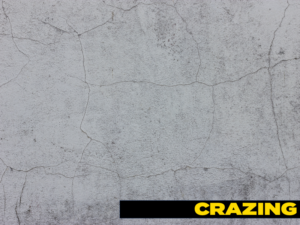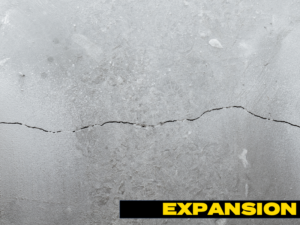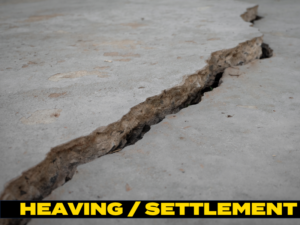Pro Tip
Diagnosing and Repairing Cracks in Concrete
For all the controversy around concrete, there’s one thing that the guys in the field and the guys in the lab agree on: all concrete is going to crack, eventually. The fundamental reason for this is that concrete is strong in compressive strength, but about 10x weaker in tensile strength. When tensile strength is exceeded by outside forces, you get a crack.
Because cracks are bound to happen, it’s important to know which cracks are dangerous and which are purely cosmetic, and if repairing cracks in concrete is necessary or not.
Category 1:
Surface Cracks 
- Crazing – Formation of crack networks due to early shrinkage of the surface layer due to wind or high temperatures; commonly occurs in garage floors.
- Plastic Shrinkage Cracks – Similar to drying shrinkage. High temperatures or windy conditions can cause the surface of the slab to lose moisture more quickly than the bottom prior to setting, leading to cracking.
- Drying shrinkage – Similar to plastic shrinkage. Excess water in the mix – or added during curing – causes the top of a slab to dry at a different rate than the bottom, creating strain within the slab that leads to cracks.
Typically, all of these types of cracks fall into the cosmetic category and do not require repairs unless they exceed 1/8” in width. Treating with a simple sealer like Sakrete Cure ‘N Seal or a water-based concrete stain will mitigate moisture intrusion and protect the slab from real damage.
Left untreated, these cracks can allow additional moisture to penetrate into the slab, leading to more extensive cracking, heaving or spalling–all of which would require more extensive repairs.
Category 2:
Structural Cracks
- Expansion – As the concrete warms and expands, it pushes against slab or brick wall, for example. Without an expansion joint to relieve the pressure, the force of expansion will crack the slab.
- Hairline Cracks – Caused by moisture intrusion in a minor imperfection that has spread throughout the slab.
Once any crack penetrates the full depth of the slab, it is considered structural and must be immediately sealed to mitigate moisture intrusion and prevent further damage to the slab. Note that this rule also applies to control joints!
The most important consideration with structural cracks is determining whether or not they are still “active”. If the crack moves – eg. widening or narrowing from summer to winter – or if it’s continuously growing, you’ve got an active crack.
When in doubt, seal the crack with a material that will remain semi-flexible, so that it may move with the crack. Rigid repairs on an active crack will just lead to new cracking beside the repair.
When repairing cracks in concrete of these types, consider using water-based siliconized latex caulks like Sakrete Crack Filler or Sakrete Concrete Repair, or heavier-duty hybrid polyurethanes like Sakrete Non-Sag and Sakrete Self-Leveling Sealants.
View the Crack Repair Pro Tips Video >>
Category 3:
Uneven Cracks 
- Settlement cracks – Caused by erosion or poor compaction of the sub-grade creating a void underneath the slab which leads to the concrete collapsing in on itself.
- Heaving cracks – Caused by movement of the sub-grade due to frost, tree roots or other environmental factors lifting one side of the slab, leading to a crack.
Any height change between two pieces of concrete indicates a problem with the sub-grade. The only true fix is demolition of the slab, re-leveling and compaction of the base layer and re-pouring new concrete.
For immediate pedestrian safety, consider creating a “ramp” of patch material, such as Sakrete Top ‘N Bond or Pro-Mix All-Purpose Cement Mix, to temporarily bridge the two levels and reduce the tripping hazard.
View the Uneven Concrete Repair Pro Tips Video >>
The major takeaway with any crack is to never ignore the problem, no matter how minor it may seem on the surface. Educate yourself, diagnose the problem, address the problem. Because as incredible as concrete is, one thing it will never do is heal itself!
Of course, cracks aren’t the only thing that can go wrong. Check out this blog post on how to assess other types of damage and decide if a partial-depth or full-depth repair is right for your job.
For more advice on surface prep before repairing cracks in concrete, contact the Sakrete Technical Team at 866-SAKRETE or via Live Chat on Sakrete.com.